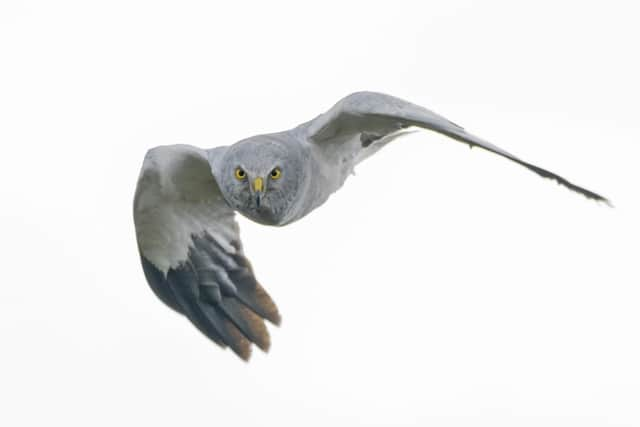Birds of prey: Scottish hen harrier population increase welcomed but ‘persecution continues’
Populations of one of Scotland's rarest and most targeted birds of prey, the hen harrier, have increased in recent years, according to new figures, offering signs of optimism for the recovery of the species.
However, numbers remain lower than 20 years ago, despite the rise.
Advertisement
Hide AdAdvertisement
Hide AdThe findings come from the latest count of hen harriers across the UK and Isle of Man, carried out last year – the first since 2016.
The results show a mixed picture, with populations expanding in some places but disappearing in others.
Scotland is home to more than three quarters of all the UK’s hen harriers, but numbers have crashed from historical levels.
The species was wiped out in mainland Scotland in the 19th century and today is graded red on the list of Birds of Conservation Concern.


The latest figures suggest 529 territorial pairs were living in Scotland last year, up 15 per cent since 2016.
The west Highlands, Hebrides and Orkney continue to be strongholds.
Counts showed particular success for the Hebridean population, now Scotland’s second largest, with around 110 territorial pairs.
This is a jump of 125 per cent since 2016, largely due to expansion on the Isle of Lewis.
Advertisement
Hide AdAdvertisement
Hide AdSignificant increases were also recorded in the east Highlands, with numbers up 69 per cent.
Orkney and the north Highlands showed rises of 15 per cent and 12 per cent respectively.
According to the report, numbers remain low and falling in parts of the mainland.
Declines were steepest in the Southern Uplands, dropping 32 per cent, while the west Highlands saw a five per cent fall.
Hen harriers feed primarily on small birds and mammals but will also eat insects, reptiles and amphibians.
Their habits mean they often descend on grouse moors, picking off young birds being reared for sport shooting.
This causes conflict with businesses and has led to high killings of the predators.
Conservationists say human persecution continues to constrain hen harrier numbers, laying much of the blame on grouse businesses.
Advertisement
Hide AdAdvertisement
Hide AdThe report comes shortly after an investigation was launched into the “sudden” and “suspicious” disappearance of a young satellite-tagged hen harrier in the Angus glens.
Duncan Orr-Ewing, head of species and land management for RSPB Scotland, says the overall increase in hen harriers is a “cause for optimism”.
He expressed hope that Scotland’s new Wildlife Management and Muirburn Bill, which will see grouse shooting businesses licenced, will help the species.
“It should provide a significant deterrent to wildlife crime, and we should now expect to see hen harrier populations on grouse moors increasing,” he said.
“The bill also contains important changes to the law with regards burning on moorland, which should improve nesting habitats for hen harriers.”
Ross Ewing, director of moorland at Scottish Land & Estates, says the hen harrier increases were “to be celebrated”, insisting that “grouse moors have an important role to play in the conservation of at-risk bird species”.
He added: “Many shooting estates have participated in initiatives aimed at improving the population in Scotland further, and grouse moor managers and gamekeepers have been happy to see hen harriers on their land as well as other raptor species.”
Comments
Want to join the conversation? Please or to comment on this article.